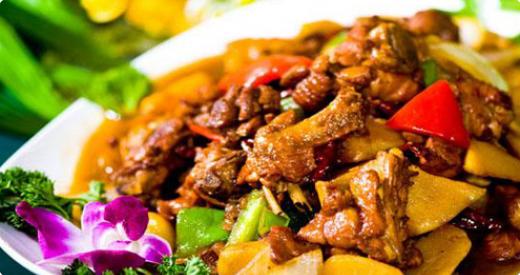
Xinjiang possesses a wide variety of ethnic minorities along with a local population of Han Chinese. In Xinjiang, the Han Chinese are one of the many minorities; here, the local Turkic Uyghurs dominate. Originally a nomadic race, travelling along the Silk Road bartering and selling their wares, the transient nature of the Uyghur lifestyle influenced the very basis of their cuisine. Many of the staple foods were designed to be cooked simply and to be transported along great distances. However, Uyghur cuisine stands out in their cooking methods, adapted for the Mongolian desert environment and setting it apart from traditional Chinese cuisine.
Basic Uyghur accompaniments to main dishes include bread and noodles, rather than the rice preferred by the Han Chinese. Langmian , freshly hand-pulled wheat noodles form the body of many meat and vegetable stir-fries and provide sustenance to soups. However, these noodles are extremely similar to the northern Chinese lamian . The city of Lanzhou, of the northwestern Gansu province in China, is famous for the same style of noodles, but here, one can find it served cold with cucumber and tomatoes for a refreshing summer dish.
Although the northern provinces of China do incorporate more noodles into their diet than the southern Chinese, rice is still more commonly found on the dinner table. Naan , another staple food, reflects the Indian Muslim origins of the Uyghur people and is an example of the many types of bread loved by the locals. While similar to the naan in the Middle East and India, the Uyghurs favour bread with salt and often add sesame seeds and butter. This crisp, golden bread is very different from the paler, softer Indian hand-rolled versions. Not just to soak up the leftover sauces from main dishes, they are also eaten on their own with tea before dinner. Several other types of bread such as sangza , flavoured wheat flour dough twists deep fried to a crisp and youtazi , steamed multi-layered bread, is also commonly seen at the dinner table. The love for bread is another step away from Han Chinese cooking and shows the less commonly seen influences from Central Asia.
Uyghur meat dishes are mostly lamb, rather than beef or chicken. While chicken can be found in kebabs and dishes such as Da Pan Ji (大盘鸡), or “Big Plate Chicken”, beef is usually eschewed due to the local Uyghur Muslim roots. Instead, lamb is used in everything- from being stuffed into sumsa and pamirdin , flakey pastries baked in a special brick oven and then deep fried into crisp golden bites, to being boiled into thick savoury soups with langmian .
Festivals are the pinnacle of lamb slaughter. The Xinjiang equivalent of Beijing roast duck, a baby lamb is usually roasted whole for these momentous occasions. After being cleaned and its internal organs removed, salt is brushed on the inside and outside, and then covered with a mixture of egg, green onion, pepper and other spices. Before being placed into a hot pit to slowly roast, the lamb’s head is covered in red silk and coriander or celery would be stuffed into its mouth to signify rebirth and the coming spring. Once ready, thick chunks would be carved off and distributed around the community.
Waste is rarely seen in Xinjiang, reminiscent of many nomadic communities. This can be seen through the popular use of animal offal, especially from lambs. “Flour-filled lungs”, a popular street snack, is sheep lung drained and cleaned of blood, filled with glutinous wheat flour, vegetable oil, salt and cumin, and then boiled for two hours until soft. “Rice sausages” are also popular: sheep intestines filled with sticky rice, oil and salt tied tightly together, then boiled and soaked in cold water repeatedly, until the rice inside infused with the rich pungent smell of umami. This is similarly seen in Chinese culture, where tripe and organs are regularly eaten. With a Muslim background set against the deserts of Mongolia, the Uyghur food offers a chance to experience a culture similar to the ancient Chinese civilisation, but still a world apart.









